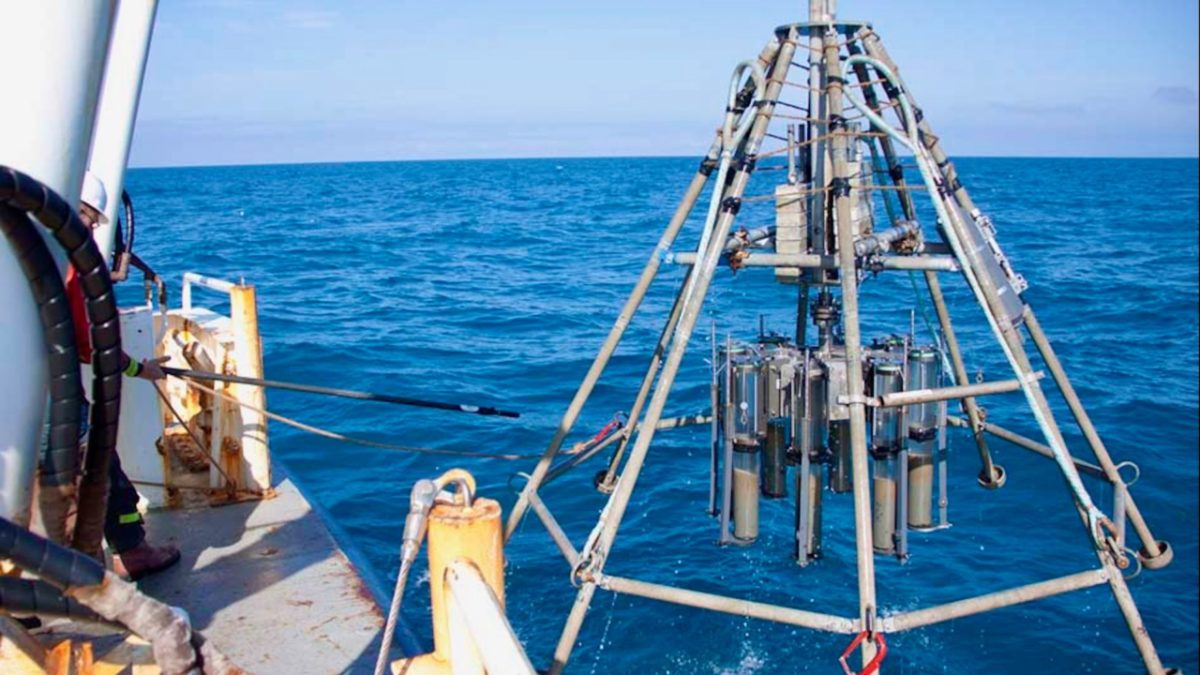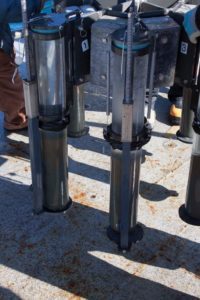Evidence of Climate Change in the North Atlantic can be Seen in the Deep Ocean, Study Finds
 A multicorer being recovered in 2014. The sediment in the tubes is approximately how much has accumulated in the past 1,000 years. (Photo by Prof. Ian Hall, Cardiff University)
A multicorer being recovered in 2014. The sediment in the tubes is approximately how much has accumulated in the past 1,000 years. (Photo by Prof. Ian Hall, Cardiff University) November 17, 2023
Woods Hole, Mass. –Evidence of climate change in the North Atlantic during the last 1,000 years can be seen in the deep ocean, according to a newly published paper led by researchers from the Woods Hole Oceanographic Institution (WHOI) and University College London.
The paper, “Surface climate signals transmitted rapidly to deep North Atlantic throughout last millennium,” published in Science, presents records from North Atlantic sediments that agree with observations of recent surface and deep ocean warming and freshening.
The scientists’ data also show a connection between the surface and the deep ocean throughout the last 1,200 years. This time period includes climate oscillations such as the warm Medieval Climate Anomaly (around 850-1250 Common Era, CE) and the cold Little Ice Age spanning around 1400-1850 CE], as well as modern warming.
“Our data provide strong support for the idea that the overflows have consistently transferred surface climate changes to the deep ocean throughout the past 1,200 years,” said article lead author Wanyi Lu, a post-doctoral scientist at WHOI.
The scientists used samples from 11 sediment cores taken from the sea south of Iceland, where overflows of cold, dense waters from the Nordic seas sink and fill the deep North Atlantic. These overflows are a part of the deep limb of the Atlantic Meridional Ocean Circulation, which acts like a conveyor belt in carrying warm surface water north from the equator and returning cool deep water south.
The Earth’s surface has gotten warmer in the past hundred years. However, the ocean has slowed this warming by absorbing and storing more than 90% of the excess heat.
“We provide evidence that the deep ocean cooled from the Medieval Climate Anomaly to the Little Ice Age. This means that the deep ocean gave heat back to the atmosphere, and therefore reduced Little Ice Age surface cooling. This is the same process –but acting in the opposite direction –that has caused the ocean to reduce modern surface warming,” said Lu.
From the sediment cores, the researchers removed the tiny fossil shells of foraminifera (single-celled organisms living in surface and deep water) and measured the chemistry of the shells. This gave the researchers information about the ocean’s environment when those foraminifera lived and formed their shells.
A key finding of the study is that most of the surface and deep records show warming and freshening during the 20th century, whereas most surface and deep records show that the Little Ice Age was cooler than the Medieval Climate Anomaly.
“The 20th-century changes we see in our surface records agree with the fast warming and freshening of North Atlantic surface waters that we know from modern measurements. This gives us confidence that the older surface and deep ocean changes we see are reliable, and that the deep North Atlantic was cooling before the current warming,” said Lu.
“Since we don't have a long record of deep ocean temperature from thermometers, these data fill an important gap” said co-author Jake Gebbie, a senior scientist and physical oceanographer at WHOI. “These observations promise to reduce our dependence on climate models to understand how Earth's climate varies.”
The study also shows that local differences and short-term changes at the ocean surface are averaged by the deep ocean. This means that in locations with a strong surface to deep connection, climate reconstructions from the deep ocean could be a better monitor than individual surface records for the timing and size of surface climate changes that took place on decadal and longer time scales.
“Many researchers focus on the upper ocean because that is where most of the excess heat is stored in the modern ocean. However, at the location where we sampled sediment cores – the overflow region where surface water from the Nordic seas flows over the Iceland-Scotland ridge and sinks to great depths – there is a pathway for heat and carbon to be transferred from the surface to the deep Atlantic,” said co-author Delia Oppo, a senior scientist and paleoceanographer at WHOI.
“Our work suggests that the deep ocean is feeling the heat that human activities have been generating. Climate change is recorded in the deep ocean.” Lu said.
Oppo added, “People should understand how important the ocean is to their climate. Without the ocean uptake of heat, global warming would be even worse than it is.”
Funding for this research was provided by the National Science Foundation; WHOI’s Edna McConnell Clark Foundation Fund; and the WHOI Postdoctoral Scholar Program, with funding provided by the Weston Howland Jr. Postdoctoral Scholarship.
Authors: Wanyi Lu1*, Delia Oppo1, Geoffrey Gebbie1, David Thornalley 1,2
Affiliations:
1) Woods Hole Oceanographic Institution, Woods Hole, MA, USA
2) Department of Geography, University College London, London, UK
*Corresponding author
###
About Woods Hole Oceanographic Institution
The Woods Hole Oceanographic Institution (WHOI) is a private, non-profit organization on Cape Cod, Massachusetts, dedicated to marine research, engineering, and higher education. Established in 1930, its primary mission is to understand the ocean and its interaction with the Earth as a whole, and to communicate an understanding of the ocean’s role in the changing global environment. WHOI’s pioneering discoveries stem from an ideal combination of science and engineering—one that has made it one of the most trusted and technically advanced leaders in basic and applied ocean research and exploration anywhere. WHOI is known for its multidisciplinary approach, superior ship operations, and unparalleled deep-sea robotics capabilities. We play a leading role in ocean observation and operate the most extensive suite of data-gathering platforms in the world. Top scientists, engineers, and students collaborate on more than 800 concurrent projects worldwide—both above and below the waves—pushing the boundaries of knowledge and possibility. For more information, please visit www.whoi.edu
Key Takeaways
- The study presents high-resolution records from North Atlantic sediments that agree with instrumental observations of 20th century surface and deep warming and freshening.
- The results suggest that Earth's cooling climate from the Medieval Climate Anomaly to the Little Ice was transmitted to the deep North Atlantic by an active overflow.
- The results imply that ocean circulation reduced the size of surface climate change that occurred between the warmest part of Medieval Climate Anomaly and the coldest part of the Little Ice Age.

